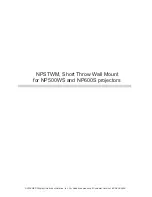
Manual, Collision Sensor,SR‑82
Document #9610‑60‑1007‑08
Pinnacle Park • 1031 Goodworth Drive • Apex, NC 27539 USA • Tel: 919.772.0115 • Fax: 919.772.8259 • www.ati‑ia.com
7
2. Product Overview
The Collision Sensor is a pneumatically‑pressurized device offering protection to industrial robots and tooling in
the event of accidental impacts and unanticipated loads. The Collision Sensor works by “breaking away” from its
working geometry in the event of excessive torsional, moment, or compressive axial forces, or any combination of
these. The Collision Sensor cannot respond to pure axial tension, which is an unlikely mode of loading. Removal of
the upsetting force or moment allows the Collision Sensor to return to its normal working position.
As a collision occurs, internal motion of the Collision Sensor components cause a switch to change state to an open
circuit. The switch circuit may be monitored by robotic controllers to stop operations before damage to the robot
or tooling occurs. The load threshold at which the Collision Sensor breaks away is adjustable by controlling the air
pressure supplied to the unit.
All Collision Sensor devices provide axial (compression only), torsional, and moment compliance.
2.1 Product description
The Collision Sensor consists of a piston housing (body) closed with a cover plate assembly. A stem
assembly protrudes through the cover plate assembly. The cover plate assembly incorporates a cam to
accurately and repeatably position the stem assembly. The stem assembly is forced into position against the
cam by a piston. The piston is supported by user supplied compressed air and an optional assist spring. The
stem provides a mounting surface for customized interface plates. Tapped and through holes on the back
surface of the body allow direct bolting of the body to the robot. All load‑bearing components and those
with wear surfaces are made of hard‑coat anodized aluminum, hardened bearing steel, or hardened tool steel.
A collision sensing switch is positioned in the side of the body. A connector block assembly containing a
Nano connector is mounted on the side of the Collision Sensor body. The user connects to the switch using
the Nano connector for which a variety of cables are available. The user must also supply the Collision
Sensor with dry, regulated, compressed air through a port on the side of the Collision Sensor body. The size
and location of these connections are shown in the drawing provided at the end of this manual.
Figure 2.1—Collision Sensor Collision Sensor








































